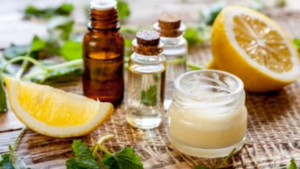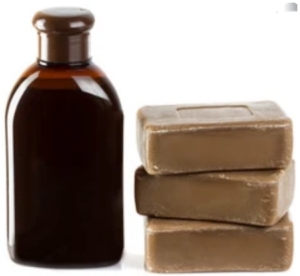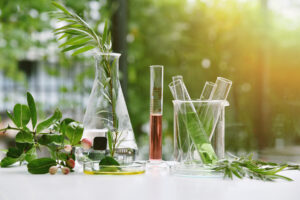Skin in the game
Personal care product advertising seems to be everywhere, particularly hyped on TV by celebrity “skinfluencers” hawking vanity lines of “natural skincare” products.
Advertising touts the need for safe and nontoxic products, suggesting that only their products are “clean” and “natural” compared to all other products in the marketplace.
The growth in the cosmetics industry (targeting women) is astounding! The average woman uses 12 such products containing 168 different chemicals each day. Similarly, sales of “natural” beauty aids are also heating up for men. Bloggers, celebrities, and social media influencers are busier than ever, convincing male consumers they need to cover up, exfoliate, firm up, or hide. In a recent survey of 4,400 men in the U.S., 20 percent of respondents reported they had worn makeup or concealer. Thirty-three percent of men ages 18-29 said they would consider wearing makeup, while another 30 percent of men ages 30-44 said they’d be open to the idea.
Clean beauty = big business
The “clean, natural skincare” business is enormous. From 2017-18, this segment of the cosmetic market grew by 23 percent to $1.6 billion, accounting for more than 25 percent of the $5.6 billion of annual skincare sales in 2018. Sales are predicted to top $7 billion by the end of 2022.
The clean beauty business touts the use of ingredients they claim to be natural or clean: the implication is that all other ingredients are therefore toxic. But there seems no rhyme or reason why certain ingredients in these products are better than others. It appears the industry is “cleanwashing” their products to make them more attractive to conscientious shoppers.
‘Clean’ and ‘natural’ may be neither
 There seems to be consensus in the cosmetic industry that “clean” refers to products that favor natural ingredients while also incorporating synthetics deemed safe for people and the planet. In other words, clean does not necessarily mean chemical-free, which is what sets it apart from brands that claim to be “natural.” Natural can be clean, but clean is not always natural; it’s just free of certain hot-button, artificial ingredients, such as parabens and formaldehyde-releasing agents (see below).
There seems to be consensus in the cosmetic industry that “clean” refers to products that favor natural ingredients while also incorporating synthetics deemed safe for people and the planet. In other words, clean does not necessarily mean chemical-free, which is what sets it apart from brands that claim to be “natural.” Natural can be clean, but clean is not always natural; it’s just free of certain hot-button, artificial ingredients, such as parabens and formaldehyde-releasing agents (see below).
Interestingly, the U.S. Food and Drug Administration (FDA), which regulates and polices personal healthcare products, has yet to define what the terms “clean” and “natural” mean. Moreover, the FDA is not required to test or preapprove cosmetics and their ingredients, except for color additives. Thus, non-dermatologist retailers, bloggers, celebrities, and customers are left to interpret these terms for themselves.
For the most part, the adjectives “clean” and “natural” appear to be nothing more than advertising terms. Without clear, agreed-upon definitions, there is no way of knowing whether a product is “safe.”
Is it a drug, or is it a cosmetic?
 The Federal Food, Drug, and Cosmetic Act (FD&C) incorporates laws related to food, drugs, and cosmetics in the U.S.
The Federal Food, Drug, and Cosmetic Act (FD&C) incorporates laws related to food, drugs, and cosmetics in the U.S.
Whether a product is a cosmetic or a drug under the law determines that product’s intended use – different regulations apply to each type of product. Companies sometimes violate the law by marketing a cosmetic with a drug claim or by marketing a drug as if it were a cosmetic without adhering to requirements for drugs.
How does the law define a cosmetic?
The FD&C Act defines cosmetics by their intended use, as “articles intended to be rubbed, poured, sprinkled, or sprayed on, introduced into, or otherwise applied to the human body … for cleansing, beautifying, promoting attractiveness, or altering the appearance.” Examples include skin moisturizers, perfumes, lipsticks, fingernail polishes, eye and facial makeup preparations, cleansing shampoos, permanent waves, hair colors, deodorants, and any substance intended for use as a component of a cosmetic product.
How does the law define a drug?
The FD&C Act defines drugs, in part, by their intended use, as “articles intended for use in the diagnosis, cure, mitigation, treatment, or prevention of disease” and “articles (other than food) intended to affect the structure or any function of the body of man or other animals.”
Can a beauty product be both a cosmetic and a drug?
Some products meet both definitions when the product has two intended uses. For example, shampoo is a cosmetic when its intended use is to cleanse the hair. An antidandruff treatment, in contrast, is a drug because its intended use is to treat dandruff; thus, antidandruff shampoo is both a cosmetic and a drug. Among other cosmetic/drug combinations are toothpastes that contain fluoride, deodorants that are also antiperspirants, and moisturizers and makeups marketed with sun-protection claims. Such products must comply with the requirements for both being a cosmetic and a drug. Drug regulations are much stricter than cosmetic regulations.
Chemicals in cosmetics
There appears to be little oversight regarding cosmetic contents in this country; it has been nearly 80 years since regulators last revised the federal safety regulations for personal health care products.
 But that could change, based on concern about rising rates of different cancers, endocrine disruptors (read this Health Yourself for more about endocrine disruptors), and recent regulatory actions taken by the European Union. Many states and the U.S. Congress are introducing legislation to increase safety for consumers, protect small businesses, and provide regulatory certainty for manufacturers.
But that could change, based on concern about rising rates of different cancers, endocrine disruptors (read this Health Yourself for more about endocrine disruptors), and recent regulatory actions taken by the European Union. Many states and the U.S. Congress are introducing legislation to increase safety for consumers, protect small businesses, and provide regulatory certainty for manufacturers.
The European Union (28 countries) has adopted more stringent and protective laws for cosmetics than we have in the U.S. The EU’s hazard-based, precautionary approach acknowledges that any chemical that links to cancer and congenital disabilities does not belong in cosmetics – regardless of the concentration.
Currently, the EU has banned more than 1,300 cosmetic chemicals found in different makeup, lotions, hair dyes, deodorants, nail polishes, shaving creams, and other beauty products. By contrast, the United States bans and restricts only 11 cosmetic chemicals.
There seems to be discordance between what we know about the science of cancer development and different skincare products and what information is disseminated to consumers. Moreover, the personal care industry has spent more than $1.5 million per year for at least 10 years to lobby Congress into dormancy. They have succeeded.
Below, I list only a few chemicals (typically found in cosmetics) banned in Europe and elsewhere but allowed in the U.S. Research suggests these chemicals relate to long-term health concerns like cancer and reproductive and endocrine dysfunction.
Be aware of these chemicals in your personal care products
The International Agency for Research on Cancer (IARC) is an intergovernmental agency and part of the World Health Organization. IARC consolidates scientific evidence and classifies the chemicals it reviews into five levels:
- Group 1: Carcinogenic to humans
- Group 2A: Probably carcinogenic to humans
- Group 2B: Possibly carcinogenic to humans
- Group 3: Not classifiable as to their carcinogenicity to humans
- Group 4: Probably not carcinogenic to humans.
Many of the 113 agents listed by IARC as known human carcinogens (Group 1 above) appear in personal care products. Here is a list of the most pervasive cosmetic chemicals sold in the U.S.
 Formaldehyde and formaldehyde-releasing preservatives (FRPs) help prevent microbes from growing in water-based products. They are absorbed through the skin and link to cancer and allergic skin reactions. They are added to hair straighteners (Brazilian blowouts), nail polish, eye shadow, mascara, nail treatment, shampoo, and blush.
Formaldehyde and formaldehyde-releasing preservatives (FRPs) help prevent microbes from growing in water-based products. They are absorbed through the skin and link to cancer and allergic skin reactions. They are added to hair straighteners (Brazilian blowouts), nail polish, eye shadow, mascara, nail treatment, shampoo, and blush.- Phenacetin was used as a pain and fever reducer until the Food and Drug Administration (FDA) banned it in 1983 due to its carcinogenicity and risk for renal damage, anemia, and breast cancer. Although it is no longer used as a drug, it can be found in such personal care products as a stabilizer in facial hair bleach, hair color, and women’s depilatories.
- Coal Tar is a known carcinogen. It is used in cosmetics containing hair dyes, shampoos, and treatment for dandruff/scalp and redness/rosacea issues. It was one of the first occupational exposures linked to cancer when young chimney sweeps saw a rise in scrotal disease. It also associates with lung, bladder, kidney, and digestive tract cancers. Coal tars are complex mixtures that can contain other known carcinogens, such as polycyclic aromatic hydrocarbons (PAHs), which are known to damage DNA. Also, exposure to PAHs can lead to tumors on the lungs, bladder, and skin. Exposure also can cause reproductive and developmental toxicity.
- Benzene derives from coal tar and is used in the production of plastics and detergents and occasionally in hair conditioners and styling lotions. It is a known human carcinogen, promotes developmental toxicity, and is a human respiratory toxicant.
- Mineral oils (untreated and mildly treated) are derived from crude oil. Most refined mineral oils contain significant amounts of PAHs capable of inducing mutations in oncogenes (any gene that causes cancer) and, by inducing multiple mutations, can result in cancerous tumor growth. Mineral oils are common in a wide array of personal care products, including eye shadow, moisturizer, lip gloss, lipstick, conditioner, hair color/bleaching, facial treatment, styling gel/lotion, blush, and concealer.
- Ethylene oxide is a possible impurity in personal care products as a byproduct of ethoxylation, a process to buffer the harsh effects of some sudsing agents. Ethylene oxide appears in fragrances, shampoos, and other sudsing items. It is most widely used to sterilize medical instruments and can be found in tobacco smoke, automobile exhausts, and foods. Strong evidence suggests ethylene oxide can lead to lymphatic and hematopoietic cancers. Some studies found an increased incidence of breast cancer in exposed workers.
- Heavy metals like hexavalent chromium and cadmium serve as colorants in eye shadow and lip gloss, soap, face cream, shampoos, and shaving creams. Other metals, such as arsenic, appear in facial lotion, shampoo, and foundation. This occurs as a result of arsenic contamination in the coloring agent D&C Red 6, aluminum starch octenylsuccinate, hydrogenated cottonseed oil, and polyvinyl acetate. Several heavy metals (cadmium, lead, arsenic) identify as human carcinogens and can also lead to developmental problems in females and males.
 Octinoxate, also called Octyl methoxycinnamate (OMC), is a UV filter found in hair color products and shampoos, sunscreen, lipstick, nail polish, and other skin creams. Octinoxate filters UV-B rays from the sun but does not protect against UV-A rays. It dissolves in oil, making it a fat-seeking substance in the body and absorbing rapidly through the skin. It has been detected in human urine, blood, and breast milk and is a potent endocrine disruptor that mimics estrogen that can disrupt thyroid function.
Octinoxate, also called Octyl methoxycinnamate (OMC), is a UV filter found in hair color products and shampoos, sunscreen, lipstick, nail polish, and other skin creams. Octinoxate filters UV-B rays from the sun but does not protect against UV-A rays. It dissolves in oil, making it a fat-seeking substance in the body and absorbing rapidly through the skin. It has been detected in human urine, blood, and breast milk and is a potent endocrine disruptor that mimics estrogen that can disrupt thyroid function. - Preservatives (parabens and formaldehyde-releasing preservatives) prevent the growth of harmful bacteria and mold in cosmetics. They appear in fragrances, lipsticks, shampoos, conditioners, lotions, moisturizers, facial and shower cleansers, nail polish, nail glue, hair gel, hair-smoothing products, baby shampoo, body wash/soap, cosmetics, and anti-aging products. Preservatives include: formaldehyde, DMDM hydantoin, quaternium-15, imidazolidinyl urea, diazolidinyl urea, polyoxymethylene urea, sodium hydroxymethylglycinate, 2-bromo-2-nitropropane-1,3-diol (bromopol), and glyoxal. Parabens associate with different cancers, endocrine disruption, developmental toxicity, reproductive toxicity, irritation, and many other health concerns.
- Phthalates (THAL-ates) are linked to endocrine disruption, developmental and reproductive toxicity, and various cancers. They appear in cosmetics, fragranced lotions, body washes, haircare products, and nail polish/treatments.
- Triclosan and triclocarban are antimicrobial agents found in many soaps and detergents, toothpaste/tooth whitening products, antiperspirants/deodorants, shaving products, creams, and color cosmetics. They act as an endocrine disruptor.
- Toluene is a toxic chemical used in nail products and hair dyes. It is found in crude oil and the tolu tree. Gasoline, paint thinners, adhesives, rubber, and hair dyes may contain toluene. Exposure to toluene can lead to headaches, dizziness, and cracked skin. More serious effects include reproductive damage and respiratory complications, organ system toxicity, and irritation.
The bottom line
Most cosmetics (i.e., chemicals) eventually absorb into the bloodstream. The cumulative effect of daily cosmetic use for years has been shown to have long-term harmful health effects: allergic reactions, cancer, developmental issues in children, liver damage, neurotoxicity, reproductive disorders, skin DNA damage, tumor growth, and endocrine, thyroid and hormone problems.
What you put on your body is as important as what you put in your body.
The Environmental Working Group is a reliable information source on these topics.
References
- Bilal, M., Iqbal, HMN. “An insight into toxicity and human-health-related adverse consequences of cosmeceuticals – A review.” Science of the Total Environment, 2019;670:555.
- Borowska, S., Brzóska M.M. “Metals in cosmetics: Implications for human health.” Journal of Applied Toxicology. 2015;35(6):551.
- Califf, R.M., Shinkai, K. “Filling in the evidence about sunscreen.” JAMA. 2019;321(21):2077.
- Campaign for Safe Cosmetics. Get the Facts: Parabens.
- Corazza, M., et al. “Use of topical herbal remedies and cosmetics: A questionnaire-based investigation in dermatology out-patients.” The Journal of the European Academy of Dermatology and Venereology. 2009; 23(11):1298.
- Deza, G., Giménez-Arnau, A.M. “Allergic contact dermatitis in preservatives: Current standing and future options.” Current Opinion in Allergy and Clinical Immunology. 2017;17(4):263
- Environmental Working Group. EWG’s Skin Deep Cosmetics Database.
- Fransway, A.F., et al. “Parabens.” Dermatitis. 2019;30(1):3.
- Lim, H.W., et al. “The burden of skin disease in the United States.” The Journal of the American Academy of Dermatology . 2017;76(5):958.
- Panico, A., et al. “Skin safety and health prevention: An overview of chemicals in cosmetic products.” The Journal of Preventive Medicine and Hygiene. 2019;60(1):E50-E57.
(Lead image credit: IRA_EVVA)




Jo Rumsey - 1971, 1976
Informing and useful as always from Vic Katch. Any recommended web sites that make it easier to identify best options would be helpful. I get overwhelmed trying to match lists of what to beware of with product labels.
Reply
Deborah Holdship
The Environmental Working Group is a reliable information source on these topics: http://www.ewg.org.
Reply
Ramona Raybin - 1962
Where can we consumers find lists of cosmetic brands that are reasonably “safe”? I visited ewg.org which is filled with information about chemicals, etc. but did not find and recommended brands. Thank you.
Reply
GPC Gateway
The “clean” beauty industry thrives on celebrity endorsements, claiming their products are safer than others. However, with the FDA not defining “clean” or “natural,” these terms often mislead consumers. Many banned substances in the EU are still in U.S. products, raising health concerns. It’s essential to read labels and research ingredients for safer choices.
Visit: https://www.gpcgateway.com/common/regulation/OA–/Q2hpbmE-/Ng–
Reply